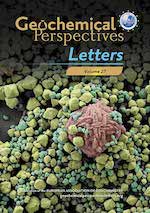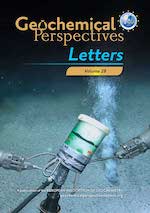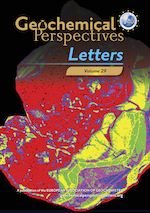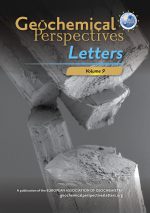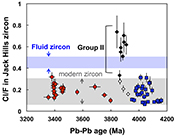 | Zircon halogen geochemistry: Insights into Hadean-Archean fluids Abstract: Understanding the distribution of halogens in rocks can potentially trace ancient lithosphere, hydrosphere, and atmosphere interactions. Although no sedimentary rocks older than 3.8 Ga are known, insights into sediment-atmosphere exchange on early Earth could be obtained from knowledge of halogen contents in ancient zircons. Here we present the first study of halogen abundances in Jack Hills zircons together with younger zircons of known provenance to provide geologic context. The relatively low (ca. 0.1-0.6 μg/g) chlorine concentrations in most Hadean and Archean Jack Hills zircons are similar to the average concentration in younger igneous zircons. In contrast, significant Cl enrichments are found in a subset of ca. 3.9–3.8 Ga zircons ([Cl]average= 1.43 ± 0.27 μg/g) that appear to record halogen transport under hydrothermal conditions. Such Cl-bearing fluids in early Earth history may reflect extraction of halogens from the interior to near surface environments. |
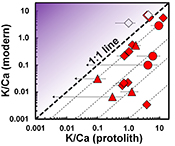 | Radiogenic Ca isotopes confirm post-formation K depletion of lower crust Abstract: Heat flow studies suggest that the lower crust has low concentrations of heat-producing elements. This could be due to either (i) greater fractions of basaltic rock at depth or (ii) metamorphic depletion of radioactive elements from rocks with more evolved (andesitic to granodioritic) compositions. However, seismic data suggest that lower crust is not predominantly basaltic, and previous studies (using Pb and Sr isotopes) have shown that lower crustal rocks have experienced significant losses of U and Rb. This loss, however, is poorly constrained for K, which is inferred to be the most important source of radioactive heat in the earliest crust. Our high precision Ca isotope measurements on a suite of granulite facies rocks and minerals from several localities show that significant losses of K (~60 % to >95 %) are associated with high temperature metamorphism. These results support models whereby reduction of heat production from the lower crust, and consequent stabilisation of continental cratons in the Precambrian, are largely due to high temperature metamorphic processes. Relative changes in whole rock K/Ca suggest that 20-30 % minimum (granitic) melt removal can explain the K depletions. |
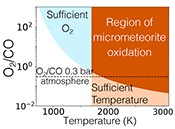 | Oxidised micrometeorites as evidence for low atmospheric pressure on the early Earth Abstract: Reconstructing a record of the partial pressure of molecular oxygen in Earth’s atmosphere is key for understanding macroevolutionary and environmental change over geological history. Recently, the oxidation state of iron in micrometeorites has been taken to imply the presence of modern Earth concentrations of oxygen in the upper atmosphere at 2.7 Ga, and therefore a highly chemically stratified atmosphere (Tomkins et al., 2016). We here explore the possibility that the mixing ratio of oxygen in Earth’s upper atmosphere, that probed by micrometeorites, may instead be sensitive to the surface atmospheric pressure. We find that the concentrations of oxygen in the upper atmosphere required for micrometeorite oxidation are achieved for a 0.3 bar atmosphere. In this case, significant water vapour reaches high up in the atmosphere and is photodissociated, leading to the formation of molecular oxygen. The presence of oxidised iron in micrometeorites at 2.7 Ga may therefore be further evidence that the atmospheric pressure at the surface of the early Earth was substantially lower than it is today. |
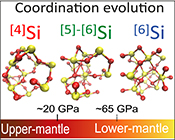 | Magma properties at deep Earth’s conditions from electronic structure of silica Abstract: SiO2 is the main component of silicate melts and thus controls their network structure and physical properties. The compressibility and viscosities of melts at depth are governed by their short range atomic and electronic structure. We measured the O K-edge and the Si L2,3-edge in silica up to 110 GPa using X-ray Raman scattering spectroscopy, and found a striking match to calculated spectra based on structures from molecular dynamic simulations. Between 20 and 27 GPa, [4]Si species are converted into a mixture of [5]Si and [6]Si species and between 60 and 70 GPa, [6]Si becomes dominant at the expense of [5]Si with no further increase up to at least 110 GPa. Coordination higher than 6 is only reached beyond 140 GPa, corroborating results from Brillouin scattering. Network modifying elements in silicate melts may shift this change in coordination to lower pressures and thus magmas could be denser than residual solids at the depth of the core-mantle boundary. |
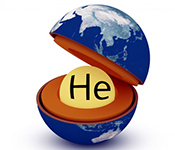 | The primordial He budget of the Earth set by percolative core formation in planetesimals Abstract: The primordial He budget of the Earth’s interior is commonly thought to have been set by full liquid metal-silicate equilibration in a terrestrial magma ocean. However, incomplete metal-silicate equilibration during accretion will have a substantial effect on this budget. Here we present liquid-solid partitioning experiments indicating that He behaves as a moderately siderophile element during percolative core formation in planetesimals. Mass balance considerations show that even minor disequilibrium will allow the Earth’s early core to incorporate sufficient primordial He—and possibly other noble gases—to supply the lower mantle throughout Earth’s history. We conclude that the high 3He/4He ratios in basalts may well represent primarily the last vestiges of metal-silicate disequilibrium in a terrestrial magma ocean preserved from the time of Earth’s formation. |
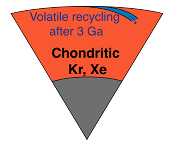 | Onset of volatile recycling into the mantle determined by xenon anomalies Abstract: Noble gases serve as unique tracers of the origin and evolution of Earth’s volatile reservoirs owing to their inert nature and contribution from extinct and extant radioactivities. However, noble gases are low in abundance relative to many other elements, particularly in the Earth’s mantle. Additionally, mantle-derived samples show large post-eruptive atmospheric contamination, rendering the determination of the primary mantle composition challenging. The sources of mantle krypton and xenon remain debated due to their partially resolvable excess, if any, relative to the atmosphere. Atmospheric noble gases also appear to be recycled into the mantle via subduction, progressively overprinting the initial mantle signature. Here we develop a new protocol to accumulate non-contaminated mantle-derived xenon, in particular the low abundant 124-126-128Xe. The results show the highest excesses in 124-126-128Xe ever measured in the mantle relative to the atmosphere and point toward a chondritic origin for mantle xenon. The fissiogenic isotopes 131-132-134-136Xe allow the onset of efficient xenon recycling in the mantle to be constrained at around 3 Gyr ago, implying that volatile recycling before 3 Ga would have been negligible. |
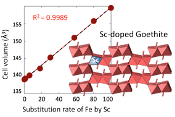 | Goethite, a tailor-made host for the critical metal scandium: The FexSc(1-x)OOH solid solution Abstract: Scandium is the subject of increasing interest and is even becoming critical for a number of institutions in Europe and the U.S.A. among others because of its economic value and supply risk. Despite this growing awareness, little is known about its geochemical behaviour. Recent studies have shown that Sc can be strongly associated with iron oxides including goethite but the mode of interaction is not yet fully understood. We investigated the incorporation of Sc in goethite structure in controlled batch systems. For the first time, we show the formation of a solid αFeOOH-αScOOH solution consistent with an ideal solution despite significant differences in atomic radii between Sc3+ and Fe3+. We believe that beyond this fundamental knowledge concerning the affinity of Sc for goethite, these results provide important insights into Sc speciation in primary or secondary sources, including Sc-rich lateritic deposits and bauxite residues after alumina extraction, for the future design of extraction processes with a low environmental footprint, as an alternative to current energy-intensive technologies. |
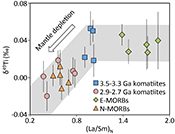 | Bridging the depleted MORB mantle and the continental crust using titanium isotopes Abstract: The mechanisms driving the chemical complementarity between depleted MORB mantle (DMM) and continental crust (with an average 'andesitic' composition) remain unclear. By investigating Archean komatiites, and modern enriched (E) and normal (N) MORB samples, we demonstrate that partial melting of the mantle does not fractionate Ti isotopes, whereas intracrustal differentiation causes significant Ti isotopic fractionation between melts and minerals, specifically Fe-Ti oxides. Thus, Ti isotope ratios are tracers of these two magmatic regimes. N-MORB and late Archean (2.9-2.7 Ga) komatiites are depleted in the heavier Ti isotopes compared to E-MORB and middle Archean (3.5-3.3 Ga) komatiites. We show that the depletion in the heavier Ti isotopes of the DMM is due to mantle recycling of the isotopically light residues from the generation of felsic continental crust over 3.5-2.7 Ga. This process must have reached a steady state by ≈ 2.5 Ga, based on the uniform Ti isotopic composition of contemporary N-MORBs and late Archean komatiites. This change is likely due to a decrease in the mantle potential temperature related to the emergence of plate tectonics. |
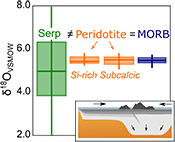 | An oxygen isotope test for the origin of Archean mantle roots Abstract: The origin of the peridotites that form cratonic mantle roots is a central issue in understanding the history and survival of Earth’s oldest continents. A long-standing hypothesis holds that the unusual bulk compositions of some cratonic peridotites stem from their origin as subducted oceanic serpentinite, dehydrated during subduction to form rigid buoyant keels (Schulze, 1986; Canil and Lee, 2009). We present oxygen isotope data from 93 mantle peridotites from five different Archean cratons to evaluate their possible origin as serpentinites. Cratonic mantle peridotite shows remarkably uniform δ18O values, identical to modern MORB-source mantle, that do not vary with bulk rock Si-enrichment or Ca-depletion. These data clearly conflict with any model for cratonic lithosphere that invokes serpentinite as a protolith for cratonic peridotite, and place additional constraints on cratonic mantle origins. We posit that the uniform δ18O was produced by sub-arc and/or MOR depletion processes and that the Si-enriched nature of some samples is unlikely to be related to slab melt infiltration. Instead, we suggest a peridotitic source of Si-enrichment, derived from ascending mantle melts, or a water-fluxed depleted mantle. These variably Si-enriched, cratonic mantle protoliths were then collisionally compressed into the thick cratonic roots that have protected Earth’s oldest continental crust for over 2.5 Gyr. |
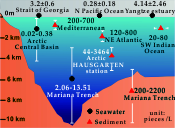 | Microplastics contaminate the deepest part of the world’s ocean Abstract: Millions of metric tons of plastics are produced annually and transported from land to the oceans. Finding the fate of the plastic debris will help define the impacts of plastic pollution in the ocean. Here, we report the abundances of microplastic in the deepest part of the world’s ocean. We found that microplastic abundances in hadal bottom waters range from 2.06 to 13.51 pieces per litre, several times higher than those in open ocean subsurface water. Moreover, microplastic abundances in hadal sediments of the Mariana Trench vary from 200 to 2200 pieces per litre, distinctly higher than those in most deep sea sediments. These results suggest that manmade plastics have contaminated the most remote and deepest places on the planet. The hadal zone is likely one of the largest sinks for microplastic debris on Earth, with unknown but potentially damaging impacts on this fragile ecosystem. |
<< Previous issueNext issue >>


